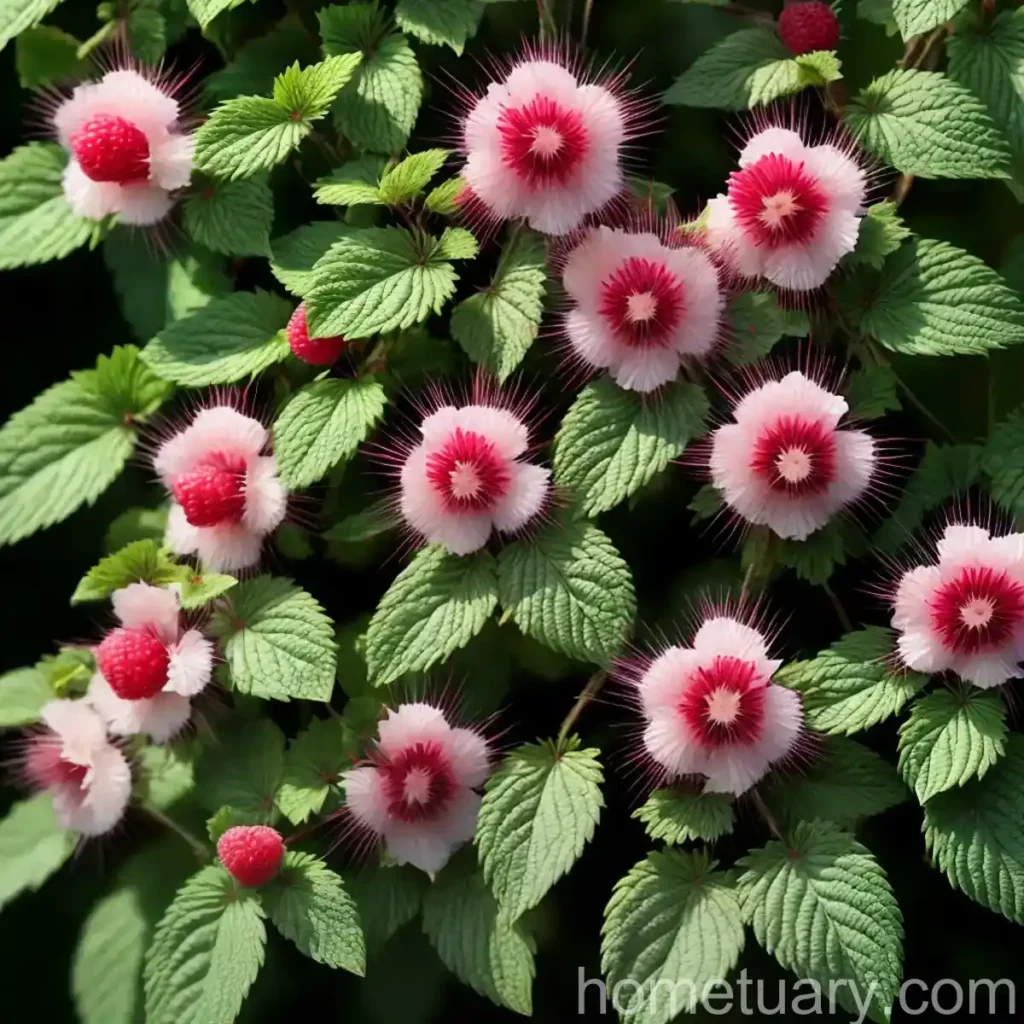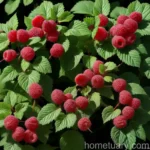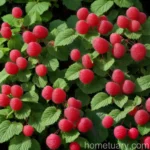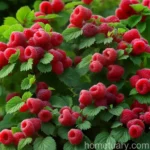The Everbearing Raspberry (Rubus idaeus ‘Kiwigold’): A Complete Guide
Raspberries are among the most beloved fruits, cherished for their sweet and tangy flavor. Among the various cultivars of raspberries, the everbearing raspberry (Rubus idaeus ‘Kiwigold’) stands out for its unique characteristics and exceptional qualities. In this comprehensive guide, we will explore everything you need to know about the everbearing raspberry, from cultivation and care to its numerous uses and benefits.
What is the Everbearing Raspberry (Rubus idaeus ‘Kiwigold’)?
The everbearing raspberry, scientifically known as Rubus idaeus ‘Kiwigold’, is a remarkable cultivar that belongs to the Rosaceae family. It is widely appreciated for its ability to produce fruit continuously throughout the growing season, making it a highly desirable addition to home gardens and commercial orchards alike. This particular variety is celebrated for its golden-yellow raspberries, setting it apart from the more common red and black raspberry cultivars. The unique color and exceptional flavor of the Kiwigold raspberry make it a sought-after choice for discerning gardeners and fruit enthusiasts.
Key Takeaways – Everbearing Raspberry (Rubus idaeus ‘Kiwigold’)
Before delving into the specifics of cultivating and caring for the everbearing raspberry, it is essential to highlight some key takeaways about this extraordinary plant. These key points will provide a concise overview of the plant’s characteristics, uses, and requirements.
Culture
The everbearing raspberry (Rubus idaeus ‘Kiwigold’) thrives in temperate climates and is prized for its ability to produce fruit continuously throughout the growing season.
Uses
The fruits of the Kiwigold raspberry are not only delicious when consumed fresh but can also be used in a variety of culinary applications, including jams, jellies, desserts, and baked goods.
Water
Adequate and consistent moisture is crucial for the successful growth and development of everbearing raspberries. However, it is important to avoid waterlogged conditions, as raspberries are susceptible to root rot in excessively wet soil.
Sunlight
Everbearing raspberries require ample sunlight to thrive and produce abundant fruit. Selecting a sunny location with at least 6-8 hours of direct sunlight is ideal for optimal fruit production.
Fertilizer
Applying a balanced fertilizer, specifically formulated for berry plants, can enhance the growth and fruiting of everbearing raspberries. It is important to follow recommended dosage and application guidelines to avoid over-fertilization.
Soil
Well-draining, loamy soil with a slightly acidic to neutral pH is best suited for growing everbearing raspberries. Amending the soil with organic matter can improve its texture and fertility, creating an ideal growing environment for the plants.
Pruning
Regular pruning is essential for managing the growth of everbearing raspberries and promoting vigorous fruiting. Proper pruning techniques help maintain plant health and productivity, ensuring a bountiful harvest.
Propagation
Everbearing raspberries can be propagated through division, suckers, or stem cuttings. Understanding the various propagation methods is valuable for expanding raspberry plantings and maintaining genetic diversity.
Container Popularity
Growing everbearing raspberries in containers has gained popularity among urban and space-constrained gardeners. Container cultivation allows for greater flexibility in placement and management of the plants.
Common Diseases
While everbearing raspberries are relatively resilient, they are susceptible to certain diseases, including anthracnose, powdery mildew, and gray mold. Implementing preventive measures and early intervention is crucial for disease management.
Common Pests
Raspberry crown borers, Japanese beetles, and spider mites are among the pests that can pose a threat to everbearing raspberry plants. Regular monitoring and appropriate pest control strategies are essential for protecting the plants from damage.
Botanist’s Tips
Botanical expertise and practical insights play a significant role in successfully cultivating and caring for everbearing raspberries. Understanding the specific needs of the plants and implementing best practices are key to achieving optimal growth and fruit production.
Fun Facts
Exploring intriguing and lesser-known facts about everbearing raspberries adds a delightful dimension to the plant’s appeal. From historical anecdotes to botanical curiosities, there is much to discover about these captivating fruits.
Now that we’ve outlined the essential facets of everbearing raspberries, let’s embark on a detailed exploration of various aspects related to the cultivation and care of Rubus idaeus ‘Kiwigold’.
Cultivation of Everbearing Raspberries
Cultivating everbearing raspberries is a rewarding endeavor that offers the satisfaction of nurturing a prolific and delicious fruit crop. From selecting the right planting site to ensuring proper maintenance, each step in the cultivation process contributes to the success of growing everbearing raspberries.
Site Selection
Choosing an appropriate site for planting everbearing raspberries is a critical first step that significantly impacts the plants’ overall health and productivity. Consider the following factors when selecting a planting location:
-
Sunlight: Everbearing raspberries thrive in full sun, requiring at least 6-8 hours of direct sunlight daily for robust growth and abundant fruit production. Select a site with ample sunlight exposure to ensure optimal plant development.
-
Soil Quality: Well-drained, loamy soil with good fertility and a slightly acidic to neutral pH is ideal for everbearing raspberries. Conduct a soil test to assess the soil’s pH and nutrient levels, and make necessary amendments to create a favorable growing environment for the plants.
-
Air Circulation: Adequate air circulation is important for minimizing the risk of fungal diseases such as powdery mildew and gray mold. Choose a site with good air movement to promote plant health and reduce the likelihood of disease development.
Planting
Once an optimal site has been identified, the next step is to plant the everbearing raspberry bushes. Follow these guidelines for successful planting:
-
Spacing: Space the raspberry plants at least 2-3 feet apart to allow for sufficient airflow and sunlight penetration between the bushes. Proper spacing helps prevent overcrowding and facilitates easier maintenance and harvesting.
-
Plant Depth: When planting bare-root raspberry canes, set them in the ground at a depth that allows the crown (the point where the roots meet the stem) to be just below the soil surface. For potted plants, ensure that the soil level matches the level of the plant in the container.
-
Mulching: Apply a layer of organic mulch, such as straw or wood chips, around the raspberry plants to conserve moisture, suppress weed growth, and maintain soil temperature. Mulching also helps prevent soil erosion and reduces the need for frequent watering.
Watering Guidelines
Proper watering is essential for the establishment and ongoing growth of everbearing raspberry plants. Follow these watering guidelines to ensure optimal moisture levels:
-
Consistency: Provide regular, consistent moisture to the raspberry plants, particularly during dry spells and periods of active growth. Aim for an inch of water per week, either through rainfall or supplemental irrigation.
-
Avoid Waterlogging: While raspberries require adequate moisture, it is important to avoid waterlogging the soil, as excessive water can lead to root rot and other adverse effects. Ensure that the planting site has good drainage to prevent water accumulation around the roots.
Fertilizing Schedule
Applying a balanced fertilizer at the right time and in the correct amounts can significantly enhance the growth and fruiting of everbearing raspberries. Follow these fertilizing guidelines for optimal plant nutrition:
-
Timing: Apply fertilizer in early spring before new growth begins, and again in early summer to support fruit development. Avoid excessive fertilization late in the season, as this can stimulate tender growth that may be susceptible to winter damage.
-
Fertilizer Type: Use a fertilizer specifically formulated for berry plants, with a balanced NPK ratio that provides essential nutrients without promoting excessive vegetative growth. Organic options, such as compost or well-aged manure, can also be beneficial for improving soil fertility.
-
Application Method: Distribute the fertilizer evenly around the base of the raspberry plants, avoiding direct contact with the stems. Water the plants after fertilization to facilitate nutrient uptake and minimize the risk of root burn.
Sunlight Requirements for Everbearing Raspberries
Everbearing raspberries are highly dependent on sunlight for their growth, fruiting, and overall health. Understanding their specific sunlight requirements is crucial for creating an optimal growing environment and maximizing fruit production.
Sun Exposure Needs
Everbearing raspberries thrive in full sun, requiring a minimum of 6-8 hours of direct sunlight per day for vigorous growth and abundant fruiting. Adequate sunlight exposure is essential for several reasons:
-
Photosynthesis: Sunlight is the primary energy source for plants, driving the process of photosynthesis that converts light energy into chemical energy, leading to the production of sugars and other essential compounds.
-
Fruiting Potential: Ample sunlight promotes the development of flower buds and subsequent fruit formation. Insufficient sunlight can lead to reduced fruiting and may affect the size, flavor, and overall quality of the raspberries.
-
Disease Prevention: Sunlight exposure helps maintain good air circulation and deters the development of fungal diseases, such as powdery mildew and gray mold, which thrive in shady and humid conditions.
Managing Shade
In some cases, it may be challenging to provide full sun exposure to everbearing raspberry plants, especially in densely shaded or confined garden spaces. When managing shade, consider the following strategies to optimize sunlight for the plants:
-
Pruning: Regularly prune surrounding vegetation, particularly trees and shrubs, to allow more sunlight to reach the raspberry plants. Thinning out overhanging branches can significantly improve light penetration.
-
Reflective Mulch: Consider using reflective mulches, such as silver or metallic-colored plastic, around the raspberry plants. These mulches can help redirect and amplify sunlight, increasing its effective reach and intensity.
-
Container Cultivation: If space constraints limit sun exposure, consider growing everbearing raspberries in containers that can be strategically positioned to capture the maximum sunlight available in the garden or on a balcony or patio.
Supplemental Lighting
In situations where natural sunlight is insufficient, supplemental lighting can be used to augment the light received by everbearing raspberry plants. When considering supplemental lighting, keep the following points in mind:
-
Types of Lights: LED (light-emitting diode) grow lights are an energy-efficient option for providing supplemental lighting to plants. These lights can be tailored to emit specific wavelengths of light that are most beneficial for plant growth.
-
Light Duration: The use of supplemental lighting should complement natural daylight and provide extended periods of illumination to compensate for inadequate sunlight. Aim for a total light duration of 10-14 hours per day for everbearing raspberry plants.
-
Light Distance: Position supplemental lights at an appropriate distance from the plants to ensure uniform light distribution without causing heat stress or light burn. Adjust the height and intensity of the lights as needed based on the plants’ response.
Maximizing Sunlight
Ultimately, maximizing sunlight exposure is key to ensuring the optimal growth and fruiting of everbearing raspberries. By understanding the importance of sunlight and implementing appropriate measures to enhance its availability, gardeners can create an environment that promotes healthy, vigorous raspberry plants and abundant harvests.
Pruning Techniques for Everbearing Raspberries
Pruning is an essential horticultural practice for managing the growth, health, and productivity of everbearing raspberry plants. By employing proper pruning techniques, gardeners can control plant vigor, encourage fruiting, and maintain overall plant vitality.
Pruning Principles
Understanding the principles of pruning is fundamental to the successful management of everbearing raspberries. The following principles guide effective pruning practices:
-
Removal of Spent Canes: Everbearing raspberries produce fruit on both old canes (floricanes) and new canes (primocanes). Pruning involves the removal of spent floricanes after fruiting to promote new growth and fruiting in subsequent seasons.
-
Thinning for Airflow and Light Penetration: Thinning out excess canes and lateral branches helps improve airflow and sunlight penetration within the plant canopy, reducing the risk of disease and promoting uniform fruit development.
-
Height Control: Pruning can help maintain the desired height of raspberry plants, preventing them from becoming overly tall and unwieldy. Controlling plant height facilitates easier maintenance and harvesting.
Pruning Schedule
The timing of pruning is crucial to the long-term health and productivity of everbearing raspberries. Understanding the seasonal pruning schedule is essential for performing the right pruning tasks at the appropriate times:
-
Summer Pruning: In early summer, after the initial fruiting period, remove the floricanes that have finished fruiting, cutting them down to ground level. This allows the plant’s energy to be redirected towards the development of new canes and subsequent fruiting.
-
Winter Pruning: During the dormant season, typically in late winter or early spring, conduct additional pruning to remove weak or damaged canes, as well as any lateral branches that may impede airflow or light penetration. This helps rejuvenate the plant and maintains its vigor.
Pruning Techniques
Utilize the following techniques to effectively prune everbearing raspberry plants, promoting their overall health and ensuring abundant fruit production:
-
Selective Cane Removal: Identify and remove spent floricanes that have completed their fruiting cycle, cutting them at ground level to encourage the emergence of new canes.
-
Lateral Branch Pruning: Thin out lateral branches by selectively removing excessive growth and overcrowded branches. This opens up the plant canopy, improving air circulation and light exposure.
-
Height Adjustment: Trim the tops of raspberry canes to control plant height and promote a more compact, manageable structure. This helps prevent the plants from becoming too tall and unwieldy.
-
Sanitation: Remove and dispose of pruned canes and plant debris to prevent the accumulation of potential disease sources and maintain a clean, healthy growing environment.
Safety Considerations
When engaging in pruning activities, it is important to prioritize safety to prevent accidents and injuries. Follow these safety guidelines when pruning everbearing raspberries:
-
Wear Protective Gear: Use gloves, long-sleeved clothing, and eye protection to shield yourself from thorns, debris, and sharp pruning tools.
-
Proper Tool Maintenance: Keep pruning tools sharp and in good working condition to ensure clean cuts and minimize effort. Clean and disinfect the tools before and after use to prevent the spread of diseases.
-
Mindful Working Environment: Work in a calm, focused manner, and be aware of your surroundings to avoid accidentally damaging adjacent plants or structures.
By incorporating these pruning techniques and principles into your management of everbearing raspberry plants, you can support their long-term vitality and ensure a bountiful harvest year after year.
Propagation of Everbearing Raspberries
The propagation of everbearing raspberries is an important aspect of maintaining and expanding raspberry plantings. By mastering various propagation methods, gardeners can multiply their raspberry stock, introduce new plants to their gardens, and share these delightful fruits with others.
Propagation Methods
Several propagation techniques can be employed to propagate everbearing raspberry plants, each offering unique advantages and considerations. Explore the following propagation methods to expand your raspberry collection:
-
Division: Everbearing raspberries can be divided by carefully separating root masses into individual sections, each containing healthy roots and a portion of the raspberry crown. This method is best performed during the dormant season and requires careful handling of the plant divisions.
-
Layering: Layering involves encouraging the formation of new roots on a stem that is still attached to the mother plant. This can be achieved by bending a low-growing cane to the ground, covering a section with soil, and allowing it to develop roots before separating it from the main plant.
-
Stem Cuttings: Propagating raspberries from stem cuttings involves taking sections of healthy, young canes and encouraging them to root in a suitable growing medium. Proper environmental and moisture conditions are essential for successful rooting and establishment of cuttings.
-
Suckers: As everbearing raspberries produce new shoots or suckers around the base of the plant, these can be carefully dug up and transplanted to create new raspberry plants. Suckers should be taken with intact root systems and handled with care during the transplanting process.
Propagation Guidelines
Successful propagation of everbearing raspberries relies on adherence to specific guidelines and best practices that support the development and establishment of new plants:
-
Selecting Parent Stock: Choose healthy, vigorous raspberry plants with desirable traits, such as robust growth, disease resistance, and flavorful fruit, as the source for propagating new plants. Selecting superior parent stock contributes to the quality of the propagated plants.
-
Optimal Timing: Perform propagation activities at the most suitable times, typically in the early spring or dormant season, when the plants are less stressed and more receptive to propagation efforts.
-
Rooting Medium: Provide an appropriate rooting medium, such as a mix of peat, perlite, and vermiculite, to encourage successful root development in propagated cuttings or divided plant sections. Maintaining proper moisture levels is crucial for rooting success.
-
Transplanting Care: Handle and transplant propagated raspberry plants with caution, ensuring that the root systems remain intact and undisturbed. Protecting the delicate roots during the transplanting process supports the establishment of new plants.
Container Propagation
For gardeners with limited space or those interested in maintaining control over the propagation process, container propagation offers a convenient and manageable approach:
-
Container Selection: Choose appropriately-sized containers with good drainage for propagating everbearing raspberry plants. Select pots that allow ample room for root development and provide a stable growing environment for the young plants.
-
Growing Conditions: Place the propagated raspberry plants in a sunny location, such as a south-facing window or outdoor patio, to provide the necessary light for growth. Maintain consistent moisture levels and protect the plants from extreme temperatures during the early stages of development.
-
Transition to the Garden: Once the propagated raspberry plants have established strong root systems and new growth, they can be gradually transitioned to the garden or larger outdoor containers for continued development.
Expansion and Diversity
In addition to maintaining existing raspberry plantings, propagation offers gardeners the opportunity to increase their raspberry stock and experiment with different varieties and characteristics. By mastering the art of propagation, you can create a diverse and thriving raspberry collection that enriches your garden and provides an abundance of delectable berries.
Everbearing Raspberry (Rubus idaeus ‘Kiwigold’): Common Diseases and Disease Diagnosis
Everbearing raspberries, including the ‘Kiwigold’ cultivar, are generally robust and resilient plants. However, they are susceptible to several diseases that can affect their growth and fruit production. Understanding the common diseases and their diagnosis is essential for effective disease management and maintaining plant health.
Common Raspberry Diseases
Several diseases can impact everbearing raspberry plants, potentially causing reduced vigor, poor fruiting, and overall decline. Here are some of the most common diseases that affect raspberries:
-
Anthracnose (Elsinoe veneta): Anthracnose is a fungal disease that affects raspberry canes, causing characteristic lesions and cankers. It can lead to reduced plant vigor and fruit quality, particularly in wet and humid conditions.
-
Powdery Mildew (Sphaerotheca macularis): Powdery mildew is a fungal disease that appears as a white powdery growth on the leaves and stems of raspberry plants. It can inhibit photosynthesis and weaken the plants, especially in dry conditions with high humidity.
-
Gray Mold (Botrytis cinerea): Gray mold is a fungal disease that affects the flowers and fruit of raspberries, causing them to rot and decay. It thrives in cool, moist conditions and can lead to significant fruit losses if left unchecked.















